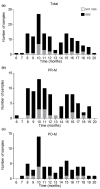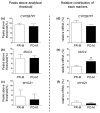An mRNA Profiling Study of Vaginal Swabs from Pre- and Postmenopausal Women
- PMID: 37623230
- PMCID: PMC10453267
- DOI: 10.3390/cimb45080411
An mRNA Profiling Study of Vaginal Swabs from Pre- and Postmenopausal Women
Abstract
Body fluid identification by means of mRNA profiling provides valuable supplementary information in forensic investigations. In particular, the detection of vaginal mucosa mRNA markers is highly relevant in sexual assault cases. Although the vagina undergoes characteristic age-related physiological changes over a lifetime, few studies have evaluated the efficacy of vaginal mRNA markers in women of different ages. In this multicentric study, a 19-plex mRNA profiling assay including vaginal-specific markers (CYP2B7P1, MUC4, MYOZ1) was tested in a collection of 6-20-month-old vaginal swabs obtained from pre- (n = 84) and postmenopausal (n = 55) female volunteer donors. Overall, participating laboratories were able to correctly identify ~85% of samples as vaginal mucosa by mRNA profiling. The assay's success rate did not differ between the two age groups and was not affected by the time interval between swab collection and RNA analysis. MYOZ1 resulted a less sensitive vaginal marker compared to MUC4 and CYP2B7P1. A significant relative increase in the contribution to the total amplification signal was observed for MUC4, compared to CYP2B7P1 and MYOZ1, in postmenopausal women. Observation of other body fluids and tissues different from vaginal mucosa was also evaluated in connection to information on previous sexual activity and menstrual cycle phase at the time of sampling.
Keywords: CYP2B7P1; MUC4; MYOZ1; body fluid identification; mRNA profiling; vaginal mucosa.
Conflict of interest statement
The authors have declared no conflict of interest.
Figures




References
-
- van den Berge M., Bhoelai B., Harteveld J., Matai A., Sijen T. Advancing Forensic RNA Typing: On Non-Target Secretions, a Nasal Mucosa Marker, a Differential Co-Extraction Protocol and the Sensitivity of DNA and RNA Profiling. Forensic Sci. Int. Genet. 2016;20:119–129. doi: 10.1016/j.fsigen.2015.10.011. - DOI - PubMed

